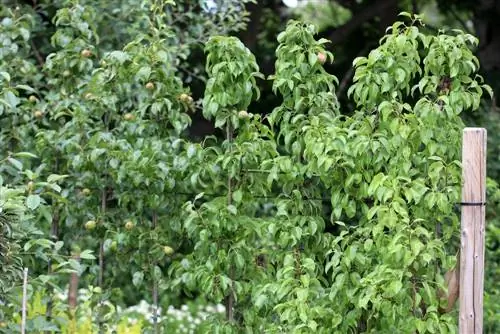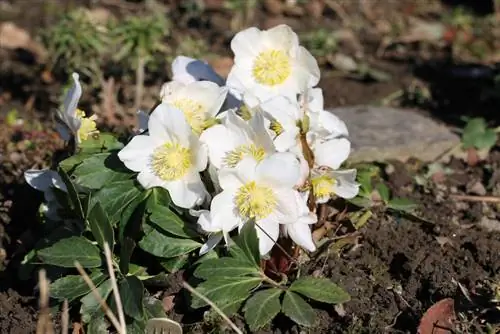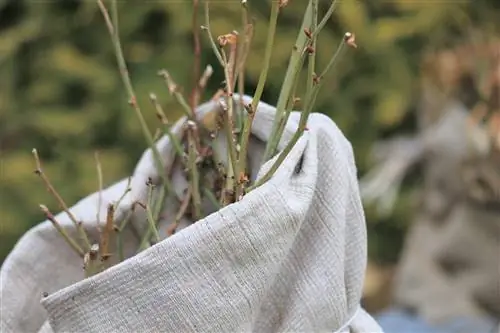- Author admin [email protected].
- Public 2023-12-17 03:39.
- Last modified 2025-01-24 12:45.
A rose does not stop working towards winter, but rather changes its metabolism in preparation for a new phase of life. It needs help in the fall to be well prepared for the winter and, in exceptional cases, both pruning and winter protection. Below you will find out what is necessary and appropriate, when, and the reasons for each recommendation:
Profile: Roses in winter
- Winter is an important phase of life for roses
- In which the plant metabolism has to cope with its tasks as in the summer season
- Just other tasks, the production of the summer season has to be brought to maturity in the winter
- The plant metabolism can best carry out the ripening processes when the rose goes into the winter optimally prepared
- You can help her with a whole range of measures
- This includes providing the right nutrients
- Summer fertilizer is replaced by potassium-rich autumn fertilizer
- This winter preparation is enough for well-cared for roses in the right place in the right climate
- All other roses need and receive winter protection
- In the article you will find out where, why and how much
Winter: An important growth phase
When the last rose petals have faded, roses are no longer an issue for us until the next summer season. Unfortunately, the roses cannot simply be stored over the winter like the touring bike, but still need a little attention. Because for the rose, winter is anything but a break, its metabolism continues, energy continues to be absorbed and processed through food.
The plant metabolism continues in the special form that has developed in the history of development for living through cold seasons. This doesn't mean the tricks that plants have developed to increase their frost hardiness (that's what we'll talk about in “Winter Protection” below); this is about what happens in the plant's metabolism when and during it survives the winter. And a lot happens:
The Rose has had a season in which one strenuous action after another had to be carried out in a time-determined manner. She let new shoots grow, decorated them with flowers in time for the insects' main flight time to ensure pollination, and "carried" the fruits resulting from this "sexual act" (or not, that would mean seed production; the flower is usually cut away beforehand).
Definitely a lot of stuff, all in a single warm season that turns into the cold season far too quickly - even for a rose plant, the summer day would probably be better than 25 hours. After the strenuous effort of piecework, a quieter pace is now in order, in which the main aim is to complete and secure the results achieved in the summer season. The plant metabolism continues; However, due to the lower ambient temperature, it is slower and is no longer aimed at “new production”, but rather at achieving other goals.
Preparing for wintertime
If winter is not just a “time out” for the rose, but an important regeneration phase with a slowed but still active plant metabolism, the rose should go into winter in a state in which it can benefit most can move from the winter time:
- As soon as the last flower has faded, the rose no longer receives summer fertilizer
- This fertilizer mixture contains nutrients that promote growth and flowering and are no longer needed
- On the contrary: the shoots produced in summer should no longer form new cells (no longer grow)
- The still very tender cells that have just been produced must now mature
- This maturing is also a kind of growth, it's just not about “longer, bigger”, but about becoming “stronger”
- As strong as possible by winter so that the rose can survive the winter cold well
- Plants use a variety of strategies (see winter protection below), including: Various elements are stored in the cells
- The mineral potassium or a special autumn-winter fertilizer with a particularly high amount of potassium helps with this
- Nitrogen (responsible for stimulating growth and shoot formation), on the other hand, should hardly be contained
- Potassium further reduces the freezing point of the cell fluid when it accumulates in the cell stores, the rose can then tolerate more cold
Tip:
If you feed your plants with natural fertilizer, the rose will get extra potassium in autumn with the following natural substances: comfrey/fern manure, mature manure, wood ash, e.g. B. compost rich in potassium from potato and banana peels, parsley stems and coffee grounds. A good supply of potassium is not only important for the roses, but also helps every plant to give its growth firm and stable structures, regardless of whether they are shoots or fruits (tomatoes, pumpkins, cucumbers etc.).
Do roses definitely need winter protection?
Roses live in a cold-blooded environment; they cannot adapt their metabolism to unfriendly temperatures any more than a cold-blooded frog can. However, their metabolism must still be able to withstand sub-zero temperatures, like the metabolism of any plant that grows in regions with sometimes frosty temperatures.
Survival in frost actually contradicts the physical laws of nature because freezing water expands. When this freezing water is in a plant cell, it explodes it; many exploded cells would kill the plant.
So plants in cold winter regions have developed strategies to prevent such “cell bursting”: The potassium, sugar (starch), lignin and other substances already mentioned are stored in the cells as “antifreeze”. Leaves are dehydrated before frost (which leads to leaf fall in temperate zones when exposed to wind); In case of doubt, the plant escapes the too cold environment by dying above ground and only allowing the roots to survive under a cozy, warm blanket of snow (which we then very appropriately call "drawing in" - not from "withdrawing", but from the energy collected in the summer absorbed into the roots before things get serious above the earth's surface).
A rose masters all three strategies, which of them it can and must use and whether additional winter protection is needed depends on the condition in which it goes into the winter. The rose's leaves die back, but usually remain attached to the branches as additional winter protection because there is little wind so far down (and to keep the roots warm if they eventually fall off). If substances are available for storage, they are stored in the shoots; If it is too cold, they will also be drawn into the roots before the rose bush leaves the top to sprout again in the spring. The poorer the nutrient composition and soil structure and the colder the climate, the greater the chance that the roots will freeze completely and this rose will “become history.”
You cannot therefore make a general statement that roses need winter protection, on the contrary. A rose that goes into the winter in a normal condition (not pruned or even stripped of leaves) and well cared for and not planted in a colder winter hardiness zone than stated in the sales description will survive the winter very well without any help. In the “rosy part” of a cottage garden, no one used to take the time to wrap the roses in any complicated way before winter.
Tip:
It is probably better for the rose if it hibernates without artificial winter protection because some hardening processes take place that we humans do not yet understand. However, if the climate in your region is going so crazy due to climate change that it often slips into negative extremes, or the ecological condition of your garden is not yet such that the rose will go into the winter well cared for, a compromise is available an: Mulch the rose with potassium-rich compost, also piling up a little around the roots. This puts a light winter coat on the roses, which also supplies the roots of the roses with nutrients.
Exceptions concern all roses that humans have influenced in such a way that they do not go into the winter in a normal condition and well cared for. This concerns the following typical cases (cutting is treated separately):
- Roses that were planted so late in the fall that no strong roots could yet be formed
- You need well-insulating winter protection packaging, fine roots are still quite sensitive
- Roses growing in a garden so tidy that they are surrounded by bare earth
- Not intended by nature, especially not in winter
- A thick layer of mulch made from decaying plant material warms these roses
- Roses that are still sprouting in late autumn or early spring and are surprised by a drop in temperature
- These roses have a crown protection, it should keep out cold wind that cools the shoots too much
- And don't allow the winter sun to come in directly to prevent evaporation and drying out
- And in the event of ground frost, additional root protection so that water can be drawn from the deep layers of the soil to supply the new shoots
- The same procedure should be followed in case of frost when the air temperatures are above zero
- Roses that are placed incorrectly in such a windy location that the leaves are blown off prematurely
- If in doubt, you need frost protection because you will be exposed to the cold unprotected
- And sun protection in the upper area, because even bare branches still evaporate some moisture
- Refined roses are often particularly sensitive to cold because this type of breeding does not exactly promote resistance
- • If in doubt, they need sun protection at the top, and an extra layer (jute, coconut, bubble wrap, straw) at the bottom above the piled up stuff (jute, coconut, bubble wrap, straw)
- It is important here that the insulating layer also covers the finishing point
- Rose stems were brought into a form that was not really cold-tolerant through breeding and rearing
- They therefore always need winter protection when they grow freely in the garden
- In the root area, the usual cover with mulch and/or brushwood, straw is sufficient
- The trunk should also be protected, including the grafting point, which is usually very unfavorable right under the crown
- It is simply completely wrapped up with the usual winter protection materials
- The crown should be wrapped in cold regions, with a thick-walled bag or a specially designed foil
If a rose goes through the winter with winter protection or sun protection, it should remain on the roses until there will definitely be no more severe frosts affecting the plant.
Tip:
If a young rose stem could get into trouble in its first winter because it was planted quite late and an exceptionally cold winter is on the horizon, you can resort to a trick: the stem is still very flexible, you can use the whole thing Rose “just turn it over”, i.e. H. Carefully lay it flat on the ground. In this state you can now “pile up” the entire rose, i.e. cover it completely with soil. An insulating layer of mulch, brushwood, etc. could then be added to this soil.accumulated if a forecast of extreme cold comes true.
Pruning in or near winter?
Several parts of a rose are pruned during a year. However, these cuts should only be made in absolute exceptional cases in winter or shortly before winter:
Flower cutting
If you e.g. For example, if you, like most gardeners, cut away spent flowers (to keep the rose looking neat and/or to encourage rebloom), you can do this to your heart's content, but if possible, you should let the last flowers of the season ripen on the rose so that they can bloom within the Changes in metabolic processes at the turn of the year can take on their normal role.
Autumn care cut
It is often said that shrub roses should undergo their usual care pruning in the fall. Today this is believed to be wrong because the plant metabolism, which works more slowly during the ripening period, has a lot of trouble closing the wounds inflicted during pruning (and because it is wiser to sacrifice shoot tips to the frost that will fall during spring pruning anyway, rather than shoots that are worth preserving a freshly trimmed framework).
Pruning is therefore always carried out in the growing season, the normal pruning is usually at the beginning, and care work due to illness can also be carried out later. In the following exceptional cases you should use scissors (again) in winter:
• Pruning work due to illness, e.g. to contain fungal infestation, must be continued
• You only want to remove “individual shoots that are growing in a different way”
• Pest nests should/must be cut out from the shoot tips
Cut before location correction
Young roses in obviously the wrong place can be transplanted in the fall if a better location is available.
To do this, the upper part of the rose is usually cut down completely so that it can grow roots in the new location over the winter and immediately start producing fresh shoots in the spring.






